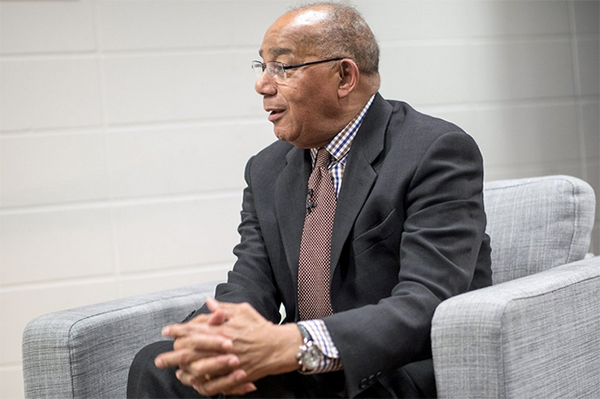NEWSLETTER
|
Robert Curvin: A Life Committed to Hope
Dr. Curvin, who had headed the Foundation’s Urban Poverty Program in the 1990s, lived in Newark most of his life, and the tributes at his death reflected the many roles he played, locally and nationally, as a civil rights leader and advocate for the poor.
“He knew everybody,” said Sharpe James, a former mayor of Newark. “Everybody knew him. He was a walking encyclopedia about where Newark’s been, where we are today and where we are going.”
That journey, of the city and the man intimately connected with its personal and public history for the past six decades, led him into careers in academia and policy-making on a national scale but always kept his vision focussed on the needs of Newark.
“He’s a legend as it relates to civil rights here in Newark,” said Ronald Rice, a Democratic state senator from Essex County. “Those of us from back in those days, we haven’t really forgotten where we come from and how much had to be done. He was one of those people, up until his demise, that recognized there’s still a lot to be done.”
Hugh B. Price, a former president of the National Urban League, told The New York Times that Dr. Curvin “never lost faith in the people and potential of his city—and by extension all industrial-age cities that have wrestled with the profound economic and demographic challenges of the post-World War II era. His scholarship, positions of influence and sheer optimism helped fuel the revitalization of struggling communities across the country.”
Dr. Curvin’s interest in civil and human rights developed early, and he joined a youth chapter of the National Association for the Advancement of Colored People (NAACP) when he was 17. His intimate understanding of the issues came early too, when he enlisted in the United States Army and served as a paratrooper with the 101st Airborne Division, the only black in his platoon at officer candidate school in Oklahoma. After five years in the service, he left as a first lieutenant.
After he graduated from the Newark branch of Rutgers University in 1960 he decided to leave the NAACP and helped found the Newark-Essex County chapter of the Congress of Racial Equality (CORE), a racially integrated national organization that agitates against police brutality and discrimination in hiring. He served for a time as the head of its Newark chapter and as a national vice chair.
He had received an undergraduate degree in biology but went to work as a welfare caseworker after college, subsequently earning a master’s degree in social work and a doctorate from Princeton University.
A signature moment in his life and career came on the night of July 12, 1967, during a time of racial upheaval throughout the country, when he took to the streets of Newark to try to quell the violence on the first night of five days and nights of urban unrest.
He was one of several local leaders invited into a police precinct to verify that an injured cabdriver, whose rumored death at the hands of the police was circulating through the city and inflaming passions, was alive.
“He displayed immense personal courage during the height of the riots,” said Hugh Price, “by grasping a bullhorn, climbing atop a car and exhorting a restive crowd not to riot and instead stage a peaceful march on City Hall.”
“Curvin pleaded for peace,” noted The Star-Ledger of Newark in its obituary, “but it was not to be.”
Dr. Curvin described the scene in an interview with National Public Radio in 2007: “There was a rain of stones, rocks, Molotov cocktails at the precinct. The flames started flickering down the side of the building, and the police came charging out with night sticks, shields, riot gear, charging the crowd.”
Twenty-three died and more than 700 were injured during the five-day period of violence that Dr. Curvin always referred to as a rebellion, not a riot. “In a rebellion,” he told The Star-Ledger in an interview in 2014, “there is at least the aim to try to affect government actions and policy. Using the word ‘riot’ suggests that all these people out there had no justifiable cause to behave in the way they did.”
He had articulated this more comprehensive view of unrest earlier in a study he co-authored with Bruce Porter on street violence in New York City in 1977, titled “Blackout Looting”. In it, he spoke of “a spiritual kind of hunger”.
He wrote, “The welfare check or the unemployment allotment is important for survival, but just surviving is not enough in a society that is constantly beating into the minds of all its citizens that all kinds of goods and luxuries are necessary for a decent life.”
He detailed the broader motivations and impulses for unrest in a book published in 2014, Inside Newark: Decline, Rebellion and the Search for Transformation. In it he noted that “no other American city except Detroit and Gary, Ind., had experienced a faster or more tumultuous racial turnover after World War II—from two-thirds white to two-thirds black within a decade.”
Dr. Curvin began working for the Ford Foundation in 1970 as a consultant and was hired as director of its Urban Poverty Program in 1988. He was named the Foundation’s vice president for communications in 1998 and retired two years later.
Among his many other activities through the years, he served as president of the Greentree Foundation, dean of the Milano School of Management and Urban Policy at the New School in New York City, chairman of the Fund for the City of New York, a member of the editorial board of The New York Times and senior policy fellow at the Edward J. Bloustein School of Planning and Public Policy at Rutgers University.
Survivors include his wife, the former Patricia Hall; his daughter, Nicole, and son, Frank; three grandchildren and a brother and four sisters.
|


